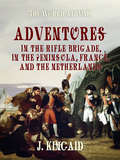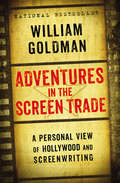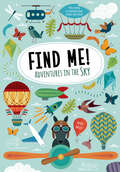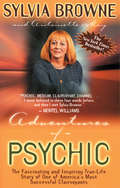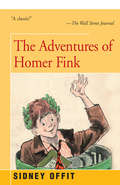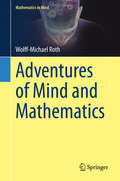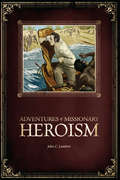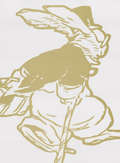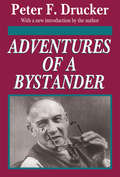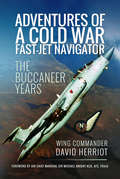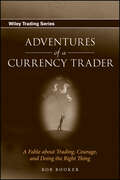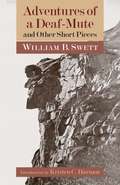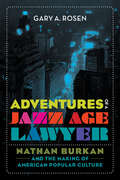- Table View
- List View
Adventures in the Rifle Brigade, in the Peninsula, France, and the Netherlands (The World At War)
by John KincaidThe memoirs of Capt. J. Kincaid covering his experiences in the famous Rifle Brigade. The Rifle Brigade (Prince Consort's Own) was an infantry rifle regiment of the British Army, formed in 1800 to provide sharpshooters, scouts and skirmishers. They later became part of the Royal Green Jackets. The brigade was distinguished by its use of green uniforms as standard in place of the traditional red, the first regular infantry corps in the British Army to do so.
Adventures in the Rifle Brigade, in the Peninsula, France, and the Netherlands from 1809 to 1815 [Illustrated and Annotated Edition]
by Pickle Partners Publishing Captain Sir John KincaidThis ebook is purpose built and is proof-read and re-type set from the original to provide an outstanding experience of reflowing text for an ebook reader. This edition contains over 60 annotations, illuminating the people and events recounted by Sir John, and also 6 maps illuminating the battles of Fuentes de Oñoro, Salamanca and Vittoria, also the sieges of Cuidad Rodrigo and Badajoz and the fortifications of Torres Vedras. Sir John Kincaid served with the 95th Rifles throughout the Peninsular War and the Waterloo campaign in 1815. Written with verve and wit and an eye for an amusing story, Adventures in the Rifle Brigade (as the 95th was known at the time), Kincaid provided an oft imitated pattern for British Rife memoirs. Published originally in 1830 the originality of the book has led to numerous re-editions since. The narrative includes; The Battles of Sabugal, Fuentes D'Oñoro, Salamanca, Vittoria, the Nivelle and Waterloo,and the sieges of Badajoz and Cuidad Rodrigo. The Text has been taken from the edition published by T. and W. Boone, 1830 London Author - Sir John Kincaid 1787-1862
Adventures in the Rocky Mountains (Great Journeys Ser.)
by Isabella BirdEndlessly restless and endlessly curious, Isabella Bird (1831-1904) travelled the world looking for new experiences, but never more delightfully than in her pony-bound adventures in the Colorado Territory at a time when it was only notionally under the control of the American authorities. A vanished world of grizzly hunters, cowboys, isolated cabins and plagues of rattlesnakes is here beautifully brought back to life.Great Journeys allows readers to travel both around the planet and back through the centuries – but also back into ideas and worlds frightening, ruthless and cruel in different ways from our own. Few reading experiences can begin to match that of engaging with writers who saw astounding things: Great civilisations, walls of ice, violent and implacable jungles, deserts and mountains, multitudes of birds and flowers new to science. Reading these books is to see the world afresh, to rediscover a time when many cultures were quite strange to each other, where legends and stories were treated as facts and in which so much was still to be discovered.
Adventures in the Scream Trade: Scenes from an Operatic Life
by Charles LongCharles Long thrilled opera audiences for more than two decades, performing on some of America's and the world's most famous stages and singing alongside some of the medium's greatest stars. Now retired, Long vividly recounts many of those experiences in this insightful, frank, and humorous memoir. Sparing no one, especially himself, from his acerbic wit and keen observations, he sheds a bright light into a world many of us respect and admire but few of us have ever encountered in such intimate detail. In the process he illustrates why the word opera, which means work in Italian, truly is a labor of love for so many who have given their all to their art.
Adventures in the Screen Trade
by William GoldmanNow available as an ebook for the first time!No one knows the writer's Hollywood more intimately than William Goldman. Two-time Academy Award-winning screenwriter and the bestselling author of Marathon Man, Tinsel, Boys and Girls Together, and other novels, Goldman now takes you into Hollywood's inner sanctums...on and behind the scenes for Butch Cassidy and the Sundance Kid, All the President's Men, and other films...into the plush offices of Hollywood producers...into the working lives of acting greats such as Redford, Olivier, Newman, and Hoffman...and into his own professional experiences and creative thought processes in the crafting of screenplays. You get a firsthand look at why and how films get made and what elements make a good screenplay. Says columnist Liz Smith, "You'll be fascinated.
Adventures in the Sky (Find Me!)
by Agnese BaruzziHave a howling good time with Bernard the Wolf as he takes to the skies—and space—with this delightful collection of seek-and-find puzzles. Bernard the Wolf is back in another thrilling seek-and-find adventure! This time, he&’s flying high up in the sky with the help of his new friend, Enrico the Robin, who&’s teaching him how to sharpen his vision. Filled with charming visual puzzles that take place in outer space, among colorful hot air balloons, inside a flock of flamingos, and more, children will have tons of fun while they develop their observation skills and practice drawing conclusions based on what they see with more than a hundred hidden object games! From determining which bird is pretending to be a wizard and which alien has a cold to what seems out of place and who is the lazy acrobat, Find Me! Adventures in the Sky is sure to entertain for hours on end! &“Find Me! seek-and-find books are a brilliant way to encourage critical thinking skills for your little one.&” —First Time Parent Magazine This is a fixed-format ebook, which preserves the design and layout of the original print book
Adventures in the South, Volume 4: Depart Switzerland
by Jacques CasanovaThis book is the number 4 of the "Adventures in the South"
Adventures in the South, Volume 4e: Milan
by Jacques CasanovaAdventures in the South, book 4e "Milan"
Adventures in the West: Henry Halpin, Fur Trader and Indian Agent
by David R. ElliottThis is the story of Irish-born Henry Ross Halpin, who by the age of 16 began a long association with the fur trade and Canada’s native peoples, was thrice employed by the Hudson’s Bay Company, and became an Indian agent (18851901). Halpin’s work took him from Fort Garry, Manitoba, to Fort York on the shores of the Hudson Bay, and across the Prairies to British Columbia. This book is based on Halpin’s previously unpublished menoirs, Hudson’s Bay Company post journals and correspondence, the 1885 Rebellion trials where Halpin was a witness, and the reports and correspondence of the Department of Indian Affairs.
Adventures of A Psychic: The Fascinating And Inspiring True-life Story Of One Of America's Most Successful Clairvoyants (Signet Ser.)
by Sylvia Browne Antoinette MayIn this uniquely fascinating book, world-renowned psychic Sylvia Browne recounts her captivating life as a clairvoyant, telling of her earliest "readings" as a young child in Kansas City, and of her first contact with "Francine," her spirit guide. In engrossing detail, Sylvia tells how her "gift" has assisted police departments in their search for missing children and dangerous criminals—and how her predictions of deaths, plane crashes, and momentous world events were sometimes heeded—or tragically ignored. But more than anything else, this is the remarkable story of one woman’s psychic odyssey, for it offers illuminating insight into how we can better understand ourselves and our own psychic abilities. ADVENTURES OF A PSYCHIC may give you an entirely new outlook on life, death, psychic phenomena, and the "other side!"
Adventures of Don Quixote: Activity Book (Amplify Core Knowledge Language Arts, Grade 5 #Unit 4)
by Amplify EducationNIMAC-sourced textbook
Adventures of Homer Fink
by Paul Galdone Sidney OffitHomer Fink could speak Latin and Greek or chart the orbit of the planet Jupiter, but when it came to tying his shoelaces or knotting his tie Homer was helpless. The Adventures of Homer Fink is a story of youth's first awareness of power and philosophy and love. It is peopled with characters as real as your next-door neighbors and yet uniquely extraordinary. Above all, this is a tale full of humor and affection and the wonder of growing up.
Adventures of Little Joe Otter
by Thornton W. BurgessAdventures of Little Joe Otter by Thornton W. Burgess
Adventures of Mind and Mathematics (Mathematics in Mind)
by Wolff-Michael RothThis monograph uses the concept and category of “event” in the study of mathematics as it emerges from an interaction between levels of cognition, from the bodily experiences to symbolism. It is subdivided into three parts.The first moves from a general characterization of the classical approach to mathematical cognition and mind toward laying the foundations for a view on the mathematical mind that differs from going approaches in placing primacy on events.The second articulates some common phenomena–mathematical thought, mathematical sign, mathematical form, mathematical reason and its development, and affect in mathematics–in new ways that are based on the previously developed ontology of events. The final part has more encompassing phenomena as its content, most prominently the thinking body of mathematics, the experience in and of mathematics, and the relationship between experience and mind. The volume is well-suited for anyone with a broad interest in educational theory and/or social development, or with a broad background in psychology.
Adventures of Missionary Heroism: True Stories Of The Intrepid Bravery And Stirring Adventures Of Missionaries With Uncivilized Man, Wild Beasts, And The Forces Of Nature In All Parts Of The World
by John C LambertBe inspired by stirring true accounts of famous missionaries! During the 19th century, many courageous and faithful missionaries were traveling to the ends of the earth to spread the Gospel. They braved innumerable dangers, toils, and tragedies. Originally published in 1912, each chapter within this volume is devoted to ). missionary and provides a biography, as well as stories of their time in the field. Meet over 20 inspiring individuals of faith Discover their call to missions service and their sacrifices Explore the dangers and challenges of these pioneering servants of Christ In addition, the book also highlights the work these believers accomplished, such as translating the Bible, providing medical aid, and converting people to Christianity. This book covers missionaries from around the world and from several different Christian denominations who served in Asia, Africa, North America, South America, and the Pacific. May these stories of those who have gone before inspire and encourage the current and future ranks of Christians, both young and old alike, to give everything for the sake of Jesus Christ.
Adventures of Perception: Essays / Interviews
by Scott MacdonaldIn this collection of thematically related personal essays and conversations with filmmakers, the author takes us on a fascinating journey into many under-explored territories of cinema.
Adventures of Uncle Wiggily: Adventures Of The Rabbit Gentleman With The Mother (Dover Children's Classics)
by Howard Garis Louis WisaGenerations of children and adults have thrilled to the adventures of Uncle Wiggily Longears, the gentleman rabbit. These heartwarming tales from a century ago recount Uncle Wiggily's devotion to helping children and animals--and himself--out of perilous scrapes. The wise old rabbit saves the day, using a combination of wit, sincerity, positive thinking, and other timeless virtues.This beautiful keepsake edition features 19 of Uncle Wiggily's most popular exploits, all accompanied by vivid colorful versions of the original illustrations. The two-color images have been given new life with wonderfully vibrant tones that add to the fun of Uncle Wiggily's adventures. Join the old gentleman rabbit's family circle--including Sammie and Susie Littletail, the bunny children; the puppies Jackie and Peetie Bow-Wow; and Billie and Johnnie Bushytail, the squirrel boys--for fun in their forest home. And when Dr. Possum advises Uncle Wiggily to travel, you, too, can come along to discover other fields and forests and meet new friends.
Adventures of a Bystander
by Peter DruckerPeter Drucker's lively and thoughtful memoirs are now available in paperback with a new introduction by the author. He writes with wit and spirit about people he has encountered in a long and varied life, including Sigmund Freud, Henry Luce, Alfred Sloan, John L. Lewis, and Marshall McLuhan. After beginning with his childhood in Vienna during and after World War I, Drucker moves on to Europe in the 1920s and early 1930s, describing the imminent doom posed by Hitler and the Nazis. He then goes on to describe London during the 1930s, America during the New Deal era, the World War II years, and beyond.According to John Brooks of The New York Times Book Review, "Peter Drucker is at a corner cafe, delightfully regaling anyone who will listen with tales of what must be one of the more varied—and for a practitioner of such a narrow skill as that of management counseling, astonishing—of contemporary professional lives." Dorothy Rabinowitz of the Washington Post writes, "The famous are here as well as the infamous.... All are the beneficiaries, for better or for worse, of Drucker's unerring eye for psychological detail, his remorseless curiosity, and his imaginative sympathy.... Drucker's book appears in a stroke to have restored the art of the memoir and of the essay."Adventures of a Bystander reflects Drucker's vitality, infinite curiosity, and interest in people, ideas, and the forces behind them. His book is a personal and informal account of the rich life of an independent man of letters, a life that spans eight decades and two continents. It will be of interest to scholars and professionals in the business world, historians, sociologists, and admirers of Peter Drucker.
Adventures of a Bystander (Trailblazers Ser. #Vol. 2)
by Peter DruckerPeter Drucker's lively and thoughtful memoirs are now available in paperback with a new introduction by the author. He writes with wit and spirit about people he has encountered in a long and varied life, including Sigmund Freud, Henry Luce, Alfred Sloan, John L. Lewis, and Marshall McLuhan. After beginning with his childhood in Vienna during and after World War I, Drucker moves on to Europe in the 1920s and early 1930s, describing the imminent doom posed by Hitler and the Nazis. He then goes on to describe London during the 1930s, America during the New Deal era, the World War II years, and beyond. According to John Brooks of The New York Times Book Review, "Peter Drucker is at a corner cafe, delightfully regaling anyone who will listen with tales of what must be one of the more varied—and for a practitioner of such a narrow skill as that of management counseling, astonishing—of contemporary professional lives." Dorothy Rabinowitz of the Washington Post writes, "The famous are here as well as the infamous.... All are the beneficiaries, for better or for worse, of Drucker's unerring eye for psychological detail, his remorseless curiosity, and his imaginative sympathy.... Drucker's book appears in a stroke to have restored the art of the memoir and of the essay." Adventures of a Bystander reflects Drucker's vitality, infinite curiosity, and interest in people, ideas, and the forces behind them. His book is a personal and informal account of the rich life of an independent man of letters, a life that spans eight decades and two continents. It will be of interest to scholars and professionals in the business world, historians, sociologists, and admirers of Peter Drucker.
Adventures of a Christmas Elf: The perfect festive family gift from Chief Elf and million-copy selling Ben Miller (Christmas Elf Chronicles #3)
by Ben MillerDiscover the joy of gift giving and meet Santa himself in the perfect stocking filler from the million-copy selling actor, author and comedian, Ben Miller.'Wonderful, funny, magical' Chris Evans'Bubbles with warmth and mischievous humour . . . irresistible' Alexander Armstrong Father Christmas needs a holiday. He isn't feeling well and someone seems determined to ruin the festivities. It's up to Christmas Elves, Tog and Holly, to find a way to deliver the presents on time and bring the Christmas magic back for everyone. A laugh-out-loud race against time from Ben Miller! Discover the magic of life as a Christmas Elf in all three laugh-out-loud stories that will take you round the world on Santa&’s sleigh, including Diary of a Christmas Elf and Secrets of a Christmas Elf. Create the perfect festive bookshelf for all the family with Chief Elf, Ben Miller: Meet Santa himself in The Night I Met Father Christmas, a brand-new picture book for 3+ readers, illustrated by Elisa Paganelli. Join the toy workshop as a Christmas Elf in all three pocket-sized stocking fillers for 7+ readers: Diary of a Christmas Elf, Secrets of a Christmas Elf, and Adventures of a Christmas Elf. See where it all began, in Ben Miller's first ever novel, The Night I Met Father Christmas, a classic festive read for 8+ readers.
Adventures of a Cold War Fast-Jet Navigator: The Buccaneer Years
by David HerriotDavid Herriot served almost 40 years in the Royal Air Force as a navigator, first on the Buccaneer S2 and subsequently on the Tornado GR1. This volume recounts his early career operating the Buccaneer on three operational flying tours plus a tour as an instructor on the Operational Conversion Unit. With almost 2500 hours on an aircraft that was operated at high-speed, in all weathers and at ultra low-level, his task in the rear seat was a demanding one. But Herriot was more than just the guy in the back of a Buccaneer; he was, quite routinely, and often to the exasperation of his seniors, the life and soul of any party that was taking place either at home base or when overseas defending the flanks of NATO.This is an epic adventure for the aviation enthusiast, particularly those with affection for the Blackburn Buccaneer, and is one that provides a great deal more than the usual introduction to a specific aircraft type and the people who flew it. Here the reader will find an absolute insight into life on a fast jet squadron, at work and mischievous play during the Cold War and they will be introduced to some of the modern Royal Air Forces greatest characters.
Adventures of a Currency Trader
by Rob BookerPraise for ADVENTURES of a CURRENCY TRADER "A truly easy, unique, and enjoyable read! Rob has done it once again to teach us in the funniest way possible how not to make the most common trading mistakes. If you are tired of reading how-to books, this is perfect for you. I highly recommend this book to all traders. Everyone will learn something about themselves by reading this book. " -Kathy Lien, author, Day Trading the Currency Market, and Chief Strategist, www. dailyfx. com "Adventures of a Currency Trader is a must read for anyone who has ever traded or is thinking about trading in the Forex markets. Rob Booker has a unique way of taking years of market knowledge and transforming it into an educational and entertaining experience. It has quickly become a cult classic in my trading library!" -H. Jack Bouroudjian, Principal, Brewer Investment Group "Brilliant! Rob's humor and humanity shine through in this parable about trading and life. Filled with wisdom and wit, it's an exhilarating rollercoaster ride through the peaks and valleys of the learning curve, with many valuable lessons learned along the way. " -Ed Ponsi, President, FXEducator. com "Rob's fable of everyman 'Harry Banes' is destined to become a trading classic. This is both the missing piece and the foundation that comes before the strategies and methodologies. The search for the Holy Grail begins and ends in the heart and mind. The journey is authentic and real and if you're willing to take it with Rob, you will be rewarded in the end. Seldom has psychology and wisdom been so entertaining!" -Raghee Horner, trader and author of Forex Trading for Maximum Profit and Days of Forex Trading "In a series of insightful and entertaining vignettes, Rob Booker teaches both the novice and the experienced trader some hard won truths about the currency market. It's a must read book written by a guy who survived the trenches and went on to prosper in the biggest and most competitive financial market in the world. " -Boris Schlossberg, Senior Currency Strategist, Forex Capital Markets LLC, and author of Technical Analysis of the Currency Market
Adventures of a Deaf-Mute and Other Short Pieces
by Kristen C. Harmon William B. SwettIn Adventures of a Deaf-Mute, Deaf New Englander William B. Swett recounts his adventures in the White Mountains of New Hampshire in the late 1860s. Given to us in short, energetic episodes, Swett tells daring stories of narrow escapes from death and other perilous experiences during his time as a handyman and guide at the Profile House, a hotel named for the nearby Old Man of the Mountain rock formation. A popular destination, the hotel attracted myriad guests, and Swett’s tales of rugged endurance are accompanied by keen observations of the people he meets. Confident in his identity as a Deaf “mute,” he notes with wry humor the varied perceptions of deafness that he encounters. As a signing Deaf person from a prominent multigenerational Deaf family, he counters negative stereotypes with generosity and a smart wit. He takes pride in his physical abilities, which he showcases through various stunts and arduous treks in the wilderness. However, Swett’s writing also reveals a deep awareness of the fragility and precariousness of life. This is a portrait of a man testing his physical and emotional limits, written from the vantage point of someone who is no longer a young man but is still very much in the prime of his life. This collection also includes “Mr. Swett and His Diorama,” an article from 1859 in which Swett describes his miniature recreation of the Battle of Lexington, as well as Manual Alphabets, a pamphlet published in 1875 on the history of manual alphabets that includes short biographies of Thomas Hopkins Gallaudet and Laurent Clerc, two pioneers of Deaf education in the United States. The work is accompanied by a new introduction that offers a reflection on Swett’s life and the time in which he lived.
Adventures of a Female Medical Detective: In Pursuit of Smallpox and AIDS
by Mary Guinan Anne D. Mather"A rip-roaring read."—NatureFresh out of college in the 1960s, Mary Guinan aspired to be an astronaut—until she learned that NASA's astronaut program wasn't recruiting women. Instead, Guinan went to medical school and became a disease detective with the Centers for Disease Control and Prevention's Epidemic Intelligence Service. Selected to join India's Smallpox Eradication program, Guinan traveled to remote villages to isolate smallpox cases and then vaccinate all uninfected persons within a ten-mile radius. By May 1975, the World Health Organization declared Uttar Pradesh smallpox-free.During her barrier-breaking career, Dr. Guinan met arms-seeking Afghan insurgents in Pakistan and got caught in the crossfire between religious groups in Lebanon. She was one of the first medical detectives on the ground in San Francisco at the start of the AIDS crisis. And she served as an expert witness in a landmark decision that still protects HIV patients from workplace discrimination. Randy Shilts's best-selling book on the epidemic, And the Band Played On, features her AIDS work, as does the HBO movie of the same name.In Adventures of a Female Medical Detective, Guinan weaves together twelve vivid stories of her life in medicine, describing her individual experiences in controlling outbreaks, researching new diseases, and caring for patients the world over. Occasionally heartbreaking, sometimes hilarious, Guinan's account of her pathbreaking career will inspire public health students and future medical detectives—and give all readers insight into that part of the government exclusively devoted to protecting their health.
Adventures of a Jazz Age Lawyer: Nathan Burkan and the Making of American Popular Culture
by Gary A. RosenAdventures of a Jazz Age Lawyer is the lively story of legal giant Nathan Burkan, whose career encapsulated the coming of age of the institutions, archetypes, and attitudes that define American popular culture. With a client list that included Charlie Chaplin, Al Jolson, Frank Costello, Victor Herbert, Mae West, Gloria Morgan Vanderbilt, Arnold Rothstein, and Samuel Goldwyn, Burkan was “New York’s Spotlight Lawyer” for more than three decades. He was one of the principal authors of the epochal Copyright Act of 1909 and the guiding spirit behind the American Society of Composers, Authors, and Publishers (Ascap), which provided the first practical means for songwriters to collect royalties for public performances of their works, revolutionizing the music business and the sound of popular music. While the entertainment world adapted to the disruptive technologies of recorded sound, motion pictures, and broadcasting, Burkan’s groundbreaking work laid the legal foundation for the Great American Songbook and the Golden Age of Hollywood, and it continues to influence popular culture today.Gary A. Rosen tells stories of dramatic and uproarious courtroom confrontations, scandalous escapades of the rich and famous, and momentous clashes of powerful political, economic, and cultural forces. Out of these conflicts, the United States emerged as the world’s leading exporter of creative energy. Adventures of a Jazz Age Lawyer is an engaging look at the life of Nathan Burkan, a captivating history of entertainment and intellectual property law in the early twentieth century, and a rich source of new discoveries for anyone interested in the spirit of the Jazz Age.
